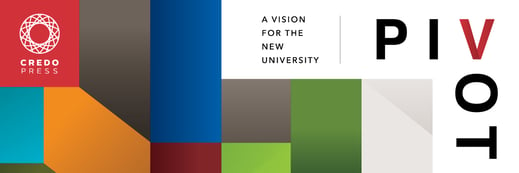
August 6 2019
The final installation of our "PIVOT" blog series is this list of common characteristics among pivoting institutions. Colleges or universities ready to make major changes will have many, if not all, of these qualities in common. Which of these traits does your institution possess; which ones are you working towards?
A Visionary Culture
A trait found on every one of these campuses is a visionary culture developed by the leadership of the president and the board of trustees. The presidents of these institutions have created an atmosphere of great hope and high expectations. Innovative projects and pilot initiatives at each institution were undertaken to prove the point of determination to succeed. Now the culture of innovation and growth has been embraced at all levels, and institutional self-esteem and momentum at each campus are thriving. The people who work at these colleges believe in what they do and believe that they do it well. They are not afraid to dream and tackle difficult challenges. It is more important to them to try, even if failing at junctures along the way, than not to have tried at all. At each of these institutions there is a prevalent theme that can be stated as simply as, “We can do this!” Such courage has allowed them to move forward with agility and speed. They positioned themselves to pivot, acted quickly and decisively, and are still acting on one initiative after another with a focus on the future.
A Strategic Plan that Connects to the Vision
Each institution has a clear, actionable strategic plan that lives out its vision. The plan is understood and embraced by the campus community and the board of trustees. There is a culture of accountability for achieving the plan, and the strategic financial investments needed to make critical initiatives happen are a top priority. The planning process itself has been collaborative but with the right balance between decision-making and inclusivity. Priorities are clear, and though initiatives are highly specific, the ability to shift and seize new opportunities and innovate along the way is woven into an iterative, continuous-planning model. These strategic plans are not incremental fixes—they represent aspirational leaps to the future. Planning has taken these colleges and universities to a place where they are focused squarely on transformative student learning and innovative experiences.
An Engaged Board
At the four institutions discussed, board members have been chosen carefully for their ability to sup-port new ways of thinking academically, administratively, and with the changing needs of the work-place in mind. From their ability to embrace new learning theories to the discerning process of careful presidential selection, they have been courageous. They enjoy a rich collaboration with institutional leadership that has made them all feel that they are making a substantial and significant difference in the lives of students. If you are a board member reading this book, we challenge you to make the board at your institution as effective and innovative as possible in order to help lead a pivot. Profound board engagement is a critical component to pivoting at each of these institutions. Board members are educated about the issues of learning today and are energized, not frightened, by the innovations of tomorrow. Board members deserve to share in the hope and excitement for the future possibilities for their institutions and for higher education as a whole.
A Unified Leadership Team
Each institution we have studied has a leadership team or president’s cabinet that is effective, action-oriented, and passionate. They are able to execute quickly as individuals and also function smoothly as a group. These teams listen carefully to shared discussions on vision and determine how to turn that vision into action. There is no possibility to position for a pivot without a strong, cohesive leadership team in place. When a leadership team is not functioning at the highest levels, there is an inability to activate solutions and inspire others to action. The best leadership teams also understand that they need to continue their own learning. Each of these teams you have read about have reached out for external help when it has been crucial to their success, embracing the right partners without hesitation. They have each other’s backs and play in each other’s sandboxes without threat and intimidation. They are healthy, functional, and engaged at all points along the way.
An Unwavering Dedication to Students
The dedication to student-centered learning inside and outside of the classroom lives at the very heart of each of these institutions. First and foremost, the leadership, faculty, and staff of these institutions nurture a deep loyalty to their students. For these colleges and universities, daily institutional life revolves around the needs of the student, with efficient operational functions creating time and space for development, learning, and creativity in service of providing learners with a rich student experience in all aspects of college life. They continue to search for ways to be sure that learning is translating into lifelong success. Advising and mentoring are present at best-practice levels, and there is a seriousness of purpose around student success at all phases of the journey.
Courage
Each institution found the courage to ask the tough questions, challenge traditional notions of higher education, explore possibilities from a variety of sources both in and outside of the sector, and to try new ideas and risk failure for the greater good of their students. Each college or university, in its own way, found the courage to recognize the changing dynamics of our world and embrace alternative ways of meeting student needs. Each continues to model for its students the courage to question, experiment, and take risks.
The circumstances of our country, our culture, our economy, and our educational system demand that all of us in higher education find ways to pivot into the future. It will take a great deal of courage and an unshakeable belief that every student deserves to learn in a way that prepares him or her for life’s journey.
We challenge you to use this book to study in teams—leadership, board of trustees, faculty, and staff—across your institution. Innovation can start with asking the simple question: why? And end with the stimulating: what if?
We hope you will find space for these conversations and weave them into your planning for the future. We urge you to position yourself to pivot, then move. Be an early adaptor and move ahead of the pack. We challenge you to serve your students better by committing yourselves with hope to the what if. The greatest reward for all of us will be in how those students are transformed by their experiences at our institutions, and in the world they will build from what they learn.
Thank you for reading this blog series! We hope you enjoyed it! To get the full text of "PIVOT: A Vision For the New University," please visit our "PIVOT" page or just click the button below.
Stay tuned to Credo's blog for future series and additional blogs about the aspects of higher education most important to you. Do you have a topic you'd like us to cover? Contact us or tweet your suggestions to @CredoHigherEd!
Are you ready for a major pivot at your college or university? How do you get started?
Innovating and creating change takes intentionality and planning. Credo takes the guesswork out of planning by providing a visual strategy map, integrative software to track your plan's progress, and, most importantly, a team of strategic planners and change managers as dedicated to your institution's success as you are. You can see one piece of our comprehensive planning process by downloading your sample strategy map. What do you think are the most important pieces to fill in on the map? Do you think your leadership colleagues would agree?
© Credo and www.credohighered.com, 2018. Unauthorized use and/or duplication of this material without express and written permission from this site’s author and/or owner is strictly prohibited. Short excerpts and links may be used, provided that full and clear credit is given to Credo, Credo Press, and www.credohighered.com with appropriate and specific direction to the original content. Please email info@credohighered.com for information on how to obtain a full copy of Pivot: A Vision for the New University or for permission to use excerpts from the book and/or blog series.
Related Blog Posts
Recent Posts
- Richard Dunsworth, J.D., To Receive 12th Annual Courageous Leadership Award December 16 2024
- Meet the 2024 Credo Values Award Recipients August 27 2024
- What is Executive Coaching, Really? June 25 2024
- Credo & The Constructive Dialogue Institute Announce A New Partnership For Higher Education Leadership Development March 7 2024
- Celebrating Women And Gender-Diverse Learners & Leaders February 28 2024
Categories
- Strategy
- Leadership
- Student Success
- Student Success & Retention
- Enrollment
- Pivot
- Strategic Planning
- Leadership Development
- News
- Strategic Enrollment
- Campus Planning and Architecture
- Moving the Needle
- Data
- Research
- Retention
- Campus Master Planning
- Enrollment & Financial Aid
- Academic Programming
- Campus Planning
- Thriving
- Admitted Student Research
- Architecture
- Finance
- Advising
- Admissions





